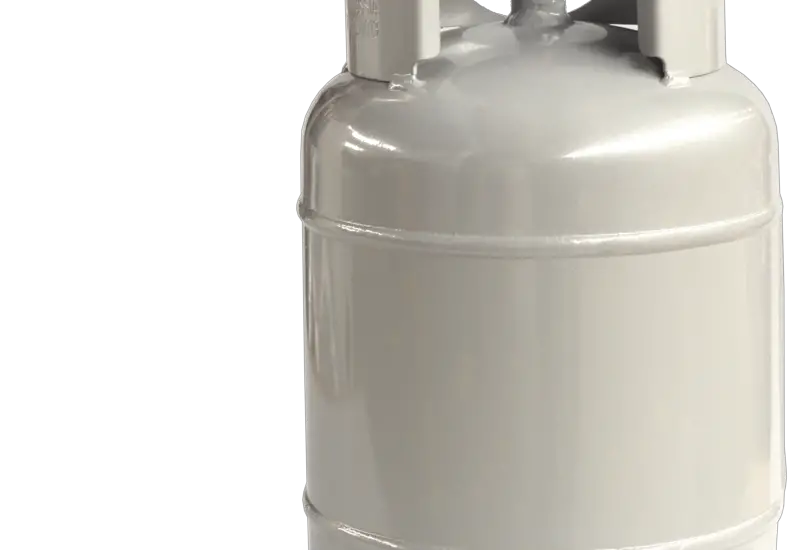In this in-depth guide, we’re going to explore what the R744 refrigerant is, why it’s important, and the vital role it plays in our everyday lives.

Table of Contents
What is R744 Refrigerant?
Now you might be asking, “What exactly is R744?” To put it simply, R744 is the industry name for carbon dioxide (CO2) when it’s used as a refrigerant. Unlike traditional refrigerants, it’s non-toxic and non-flammable, making it a pretty safe bet for cooling systems.
Composition of R744 Refrigerant
When we look at R744 up close, it’s not complex. It’s just pure CO2, something we’re all pretty familiar with. But when it’s pressurized and used in refrigeration, it works wonders. This simple yet mighty compound is what keeps our perishables fresh and our living spaces comfy.
R744 in the Refrigeration Cycle
In refrigeration, R744 operates through heat absorption and release at different pressure levels, playing a crucial role in maintaining cold temperatures across various systems.
Role of R744 in the Refrigeration Cycle
So, how does R744 work its magic in the refrigeration cycle? It all comes down to pressure. As the pressure of the R744 increases, it absorbs heat from the environment and then releases this heat at a higher temperature when the pressure is reduced. It’s like a never-ending dance of heat absorption and release.
R744 in Different Types of Refrigeration Systems
R744 isn’t picky; it’s used in all types of refrigeration systems. You’ll find it hard at work in heat pumps, air conditioning systems, and even in your home fridge. It’s a jack-of-all-trades when it comes to cooling, proving its worth time and time again.
Advantages of Using R744 Refrigerant
R744 stands out for its environmental friendliness with a low global warming potential, and excellent thermodynamic properties that promote energy efficiency.
Environmental Benefits of R744
One of the biggest perks of R744? It’s a green machine. With a global warming potential (GWP) of just 1, it’s far superior to many other refrigerants out there. Plus, it doesn’t deplete the ozone layer – it’s a real team player for our planet.
Efficiency and Performance of R744
And it’s not just about being eco-friendly; R744 also delivers on performance. It’s energy-efficient, helps to keep costs down, and has excellent thermodynamic properties. That means it can provide the same cooling effect while using less energy than some other refrigerants.
Disadvantages and Challenges of Using R744 Refrigerant
Despite its advantages, R744’s high operating pressure and reduced performance in high heat can pose challenges. However, appropriate equipment design and usage strategies can help mitigate these issues.
Potential Drawbacks of R744
R744 isn’t perfect though. Its high operating pressure can mean more wear and tear on refrigeration equipment. Plus, its performance can drop in extremely hot environments. But don’t write it off yet, because we’ve got strategies to manage these challenges.
Mitigation Strategies for R744 Drawbacks
Here’s the good news: we can tackle these drawbacks. By designing equipment specifically for high-pressure use, we can limit wear and tear. And by combining R744 with other refrigerants or using it in specific system types, we can improve its performance even in hot environments. It’s all about finding the right balance!
Check out these other related articles…
Boiling Point of Refrigerants: A Comprehensive Examination
Properties of a Refrigerant: Your Quick 411 Guide
Types of Refrigerant Used in Refrigeration Systems: Revealed
Why Boiling Point of Refrigerant Should Be Low: Explained
XP44 Refrigerant: Your Ultimate Guide
R744 Refrigerant in Commercial Applications
With its benefits outweighing the drawbacks, R744 is widely used in commercial applications. Let’s explore this further.
Use of R744 in Commercial Refrigeration
When it comes to the commercial world, R744 is often the refrigerant of choice for supermarkets, cold storage warehouses, and industrial refrigeration systems. Its efficient cooling ability and eco-friendly nature make it a responsible and practical choice for businesses.
Case Studies of R744 in Commercial Refrigeration
If you need proof, let’s take a peek at some real-world cases. Companies like Metro AG and Sainsbury’s have chosen R744 for their refrigeration needs. These big players switched to R744 and reaped the benefits, both in terms of environmental impact and energy efficiency.
Safety Guidelines for R744 Refrigerant
Like with any material in our daily life, safety is crucial when handling R744 refrigerant. So, let’s run through some key guidelines.
Handling and Storage of R744
Safety first! When handling R744, make sure it’s stored in a cool, well-ventilated area away from any source of heat. Although it’s not flammable, it can still build pressure if it gets too hot. Also, only use equipment rated for high-pressure refrigerants when dealing with R744.
Emergency Procedures for R744 Incidents
Accidents can happen, and it’s important to know what to do. In case of an R744 leak, evacuate the area and ventilate it if possible. Then, contact professionals to handle the situation. Remember, CO2 can displace oxygen, so a large leak could pose a risk.
Future of R744 Refrigerant
So, what does the future hold for R744 refrigerant? From technological advances to regulatory trends, let’s look into our crystal ball.
Technological Advances Impacting R744 Use
Technology is always advancing, and refrigeration is no exception. Innovations in equipment design, especially for high-pressure systems, are making R744 even more reliable and efficient. It’s exciting to see where these advancements will lead us!
Regulatory Trends and R744
As environmental regulations tighten around the globe, we expect R744 to become even more popular. With its low GWP and non-ozone-depleting nature, it’s perfectly placed to meet these new challenges. So, R744, it looks like your future is pretty cool!